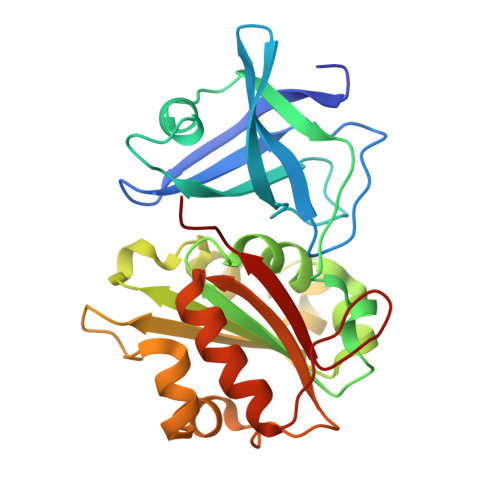New insights into the function and molecular mechanisms of Ferredoxin-NADP + reductase from Brucella ovis.
Moreno, A., Quereda-Moraleda, I., Lozano-Vallhonrat, C., Bunuel-Escudero, M., Botha, S., Kupitz, C., Lisova, S., Sierra, R., Mariani, V., Schleissner, P., Gee, L.B., Dorner, K., Schmidt, C., Han, H., Kloos, M., Smyth, P., Valerio, J., Schulz, J., de Wijn, R., Melo, D.V.M., Round, A., Trost, F., Sobolev, E., Juncheng, E., Sikorski, M., Bean, R., Martinez-Julvez, M., Martin-Garcia, J.M., Medina, M.(2024) Arch Biochem Biophys 762: 110204-110204
- PubMed: 39522858
- DOI: https://doi.org/10.1016/j.abb.2024.110204
- Primary Citation of Related Structures:
9GXB, 9GXC - PubMed Abstract:
Bacterial ferredoxin(flavodoxin)-NADP + reductases (FPR) primarily catalyze the transfer of reducing equivalents from NADPH to ferredoxin (or flavodoxin) to provide low potential reducing equivalents for the oxidoreductive metabolism. In addition, they can be implicated in regulating reactive oxygen species levels. Here we assess the functionality of FPR from B. ovis to understand its potential roles in the bacteria physiology. We prove that this FPR is active with the endogenous [2Fe-2S] Fdx ferredoxin, exhibiting a K M Fdx in the low micromolar range. At the molecular level, this study provides with the first structures of an FPR at room temperature obtained by serial femtosecond crystallography, envisaging increase in flexibility at both the adenine nucleotide moiety of FAD and the C-terminal tail. The produced microcrystals are in addition suitable for future mix-and-inject time-resolved studies with the NADP + /H coenzyme either at synchrotrons or XFELs. Furthermore, the study also predicts the ability of FPR to simultaneously interact with Fdx and NADP + /H.
Organizational Affiliation:
Departamento de Bioqu¨ªmica y Biolog¨ªa Molecular y Celular, Facultad de Ciencias, Universidad de Zaragoza, 50009 Zaragoza, Spain; Instituto de Biocomputaci¨®n y F¨ªsica de Sistemas Complejos (BIFI), and GBsC (Unizar) join Unit to CSIC, Universidad de Zaragoza, 50018 Zaragoza, Spain; Departamento de Biolog¨ªa, Facultad de Ciencias, Universidad de los Andes, Venezuela.

















